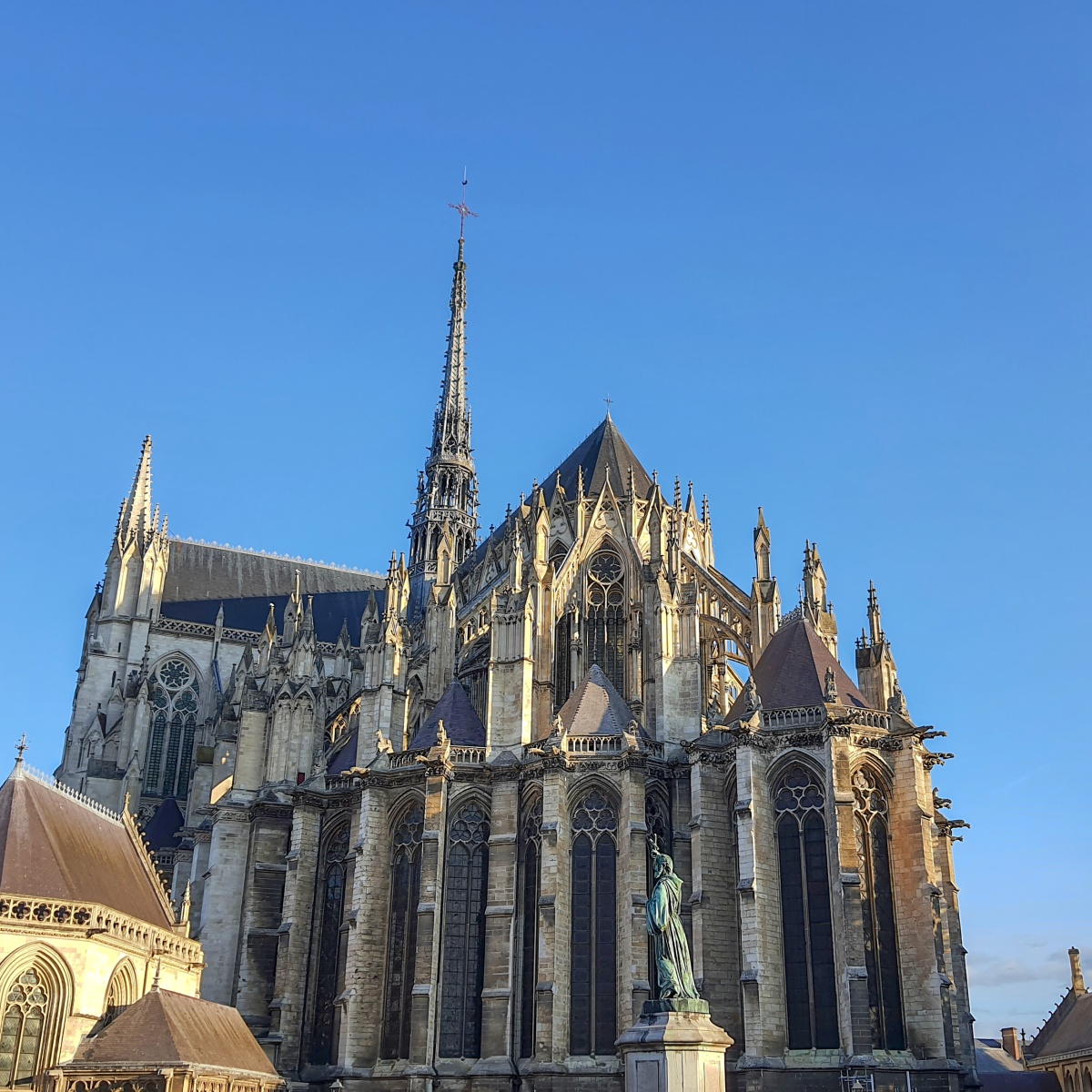
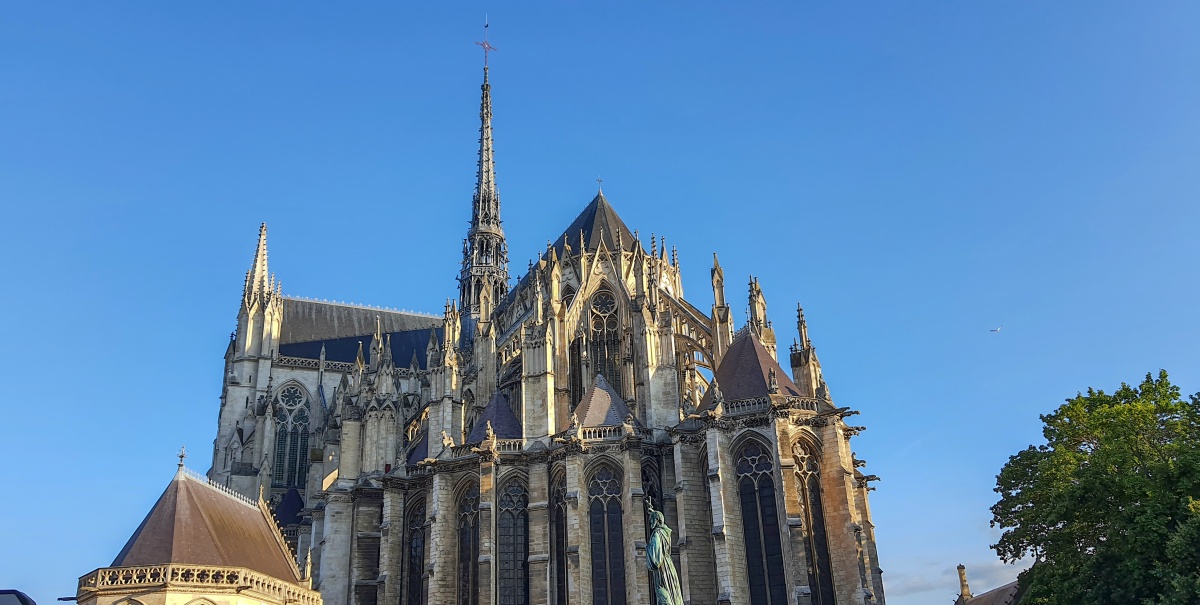
City on a Hill
Try as I might, I cannot relive Amiens Cathedral. In spite of having spent time there last summer, loitering long within its cavernous space and taking a great many photos, the experience has receded to the realm of recollection — a meagre substitute for the real thing. I am grateful for having had it, and for the lasting impression that it made on me, but I lament that I cannot go there before breakfast again to renew it, to see it in a new light or to share it with others.
Amiens was our only stop between Barcelona and the Netherlands. We went there purely for the the cathedral. It’s not that there isn’t much else to see in any cathedral city, but they do stand out, and this one more than others — it is the largest in France. The bar had been set with Chartres, the first true Gothic cathedral, finished the year that Amiens was started in 1220. I had visited Chartres half a century ago with my brother, and then studied both of them in my first year university Gothic Cathedrals course. Visiting again was high on my list.

(900×1200)
Amiens was the greatest, but certainly not the only cathedral we visited during our two month summer sojourn in Europe (twenty-one of them actually). My wife, Wendy, was very good about it. After a while, she would settle into a chair to meditate while I continued perambulating. There was space enough for both of us.
Cathedrals are for waiting. They slow the soul with their expansive embrace, covering you completely, but not smothering. They give you space to be, secure but free. They hush our busyness while bringing us to our senses. Distant sounds, streaming light, rhythmic ribs, cool pillars and ever-changing vistas nudge us to existential edges, where sacrifice and glory become intimate. Cathedrals are covenants.
Two of our children joined us in Zwolle. Laura was the only one inclined to mount the scaffolding of its Great Church to see what was once reserved for builders — a more God’s eye view. Google views have brought this experience down a notch, but technology did afford us a unique display and light show (that enthralled Jovita), bringing into vision this cathedral as it rose up from a rural hillock in our distant past to center this thriving Hansa city.
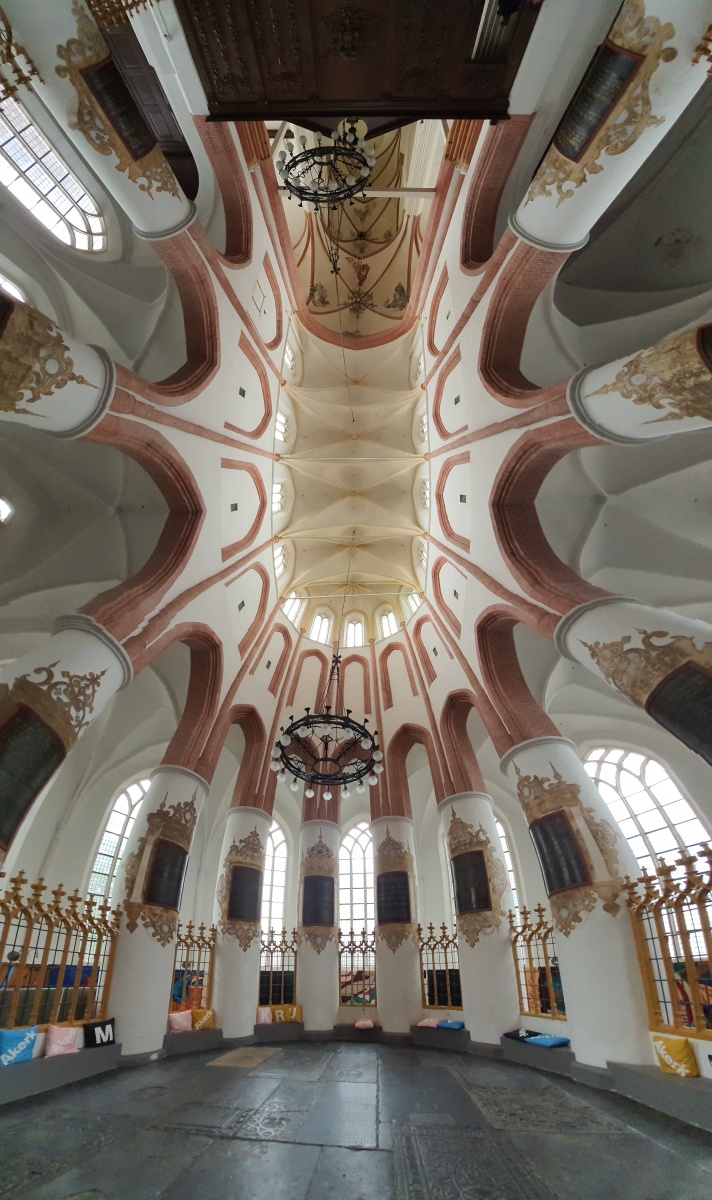
(712×1200)
Two more children joined us for the van der Laan family reunion, near the city of Groningen, and the six of us, along with two bus loads of my mother’s family, visited there and ventured into the Akerk and the Martinikerk, These once catholic cathedrals, like most churches of any size, easily survived the Reformed iconoclasms, though they did get rearranged and decluttered a bit. Clearly, the idea of the cathedral has remained as compelling as ever. The two cathedralled bookstores that we visited, in Zwolle and Maastricht, are evidence that even humanists crave sacred space.
With the reunion done, our family travelled to Brugge, back into Catholic territory, where the three churches we visited are renowned and still in active service. The Church of Our Lady (Onze Lieve Vrouwekerk), St. Salvators Cathedral and the Bascilica of the Holy Blood are primarily pilgrim destinations and worship spaces. Here the sacred places more clearly evince their fourth dimension — long, uninterrupted traditions clothing the faithful gracefully, not just now but seemingly always. These are enduring cathedral covenants.
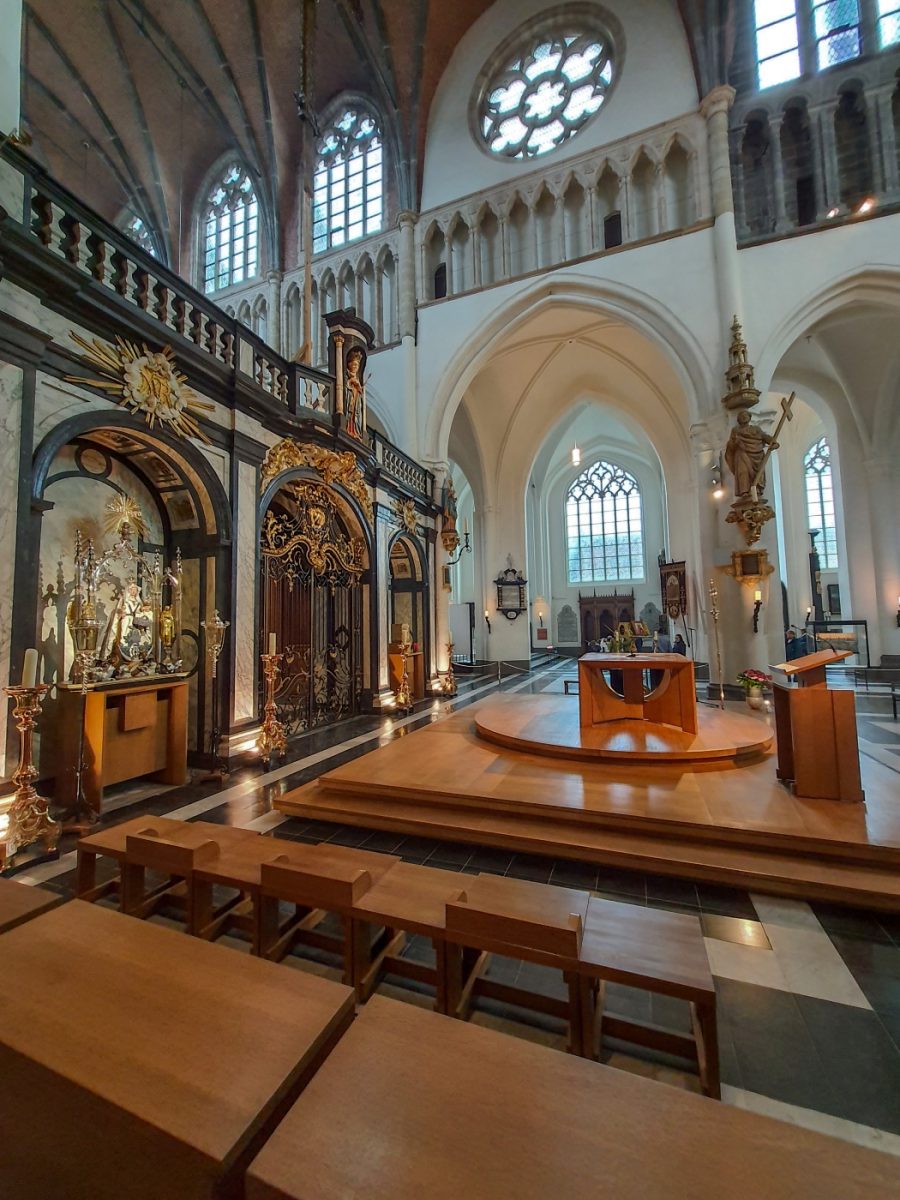
(900×1200)
Our last stop with Laura was Maastricht, where the Reformed Sint Janskerk and the Catholic St. Servaas Basilica stand side by side in their uneasy truce. The Catholics got the better of us here — their elegantly ribbed, whitewashed vaults are far loftier than those of St. John’s, which seemed relatively squat, bare-stoned and unornamented (with the exception of its organ and pulpit). More well-to-do parishes could aspire to the greatness of Chartres and Amiens — most, like Maastricht, made do.
The intentions of the more resourceful gothic cathedral builders are both well documented and simply obvious — maximum height and maximum light. Putting aside the inevitable self-aggrandizements of some key contributors, the glory of these accomplishments was meant to reflect God. Simply sincere, God-fearing builders endeavoured to shine the light of Christ into the world — to present a “city on a hill” that cannot be hidden (Mathew 5:14).
They were enduringly, endearingly successful. Up to eight hundred years later these cathedrals are still standing and receive millions of visitors yearly, quite apart from the faithful. In many places there is still no competition — the churches can be seen from afar, piercing horizons with their single-minded aspirations.
But for Christians who are not so lucky as to live in view of a cathedral, there is no surrogate ‘City of God’ asserting centrality, pressing the earth with its permanence, reaching for the heavens, bathing us in light and inviting us to stand in awe. Some of our churches echo these vaulted ideals, and of course the mountains and the hills still break forth with God’s grandeur.
Generally though, the competition has been lost. Stadiums, malls, and towers of all kinds draw the masses away from God, and the mundane iteration of streets, hydro lines, houses and strip malls distract us from any awe at all. Our worship trends to the personal and spiritual now — only the mobile-distracted mind need be engaged — and the over-arching, enduring parish presence has given way to the fractured freedom of worship.
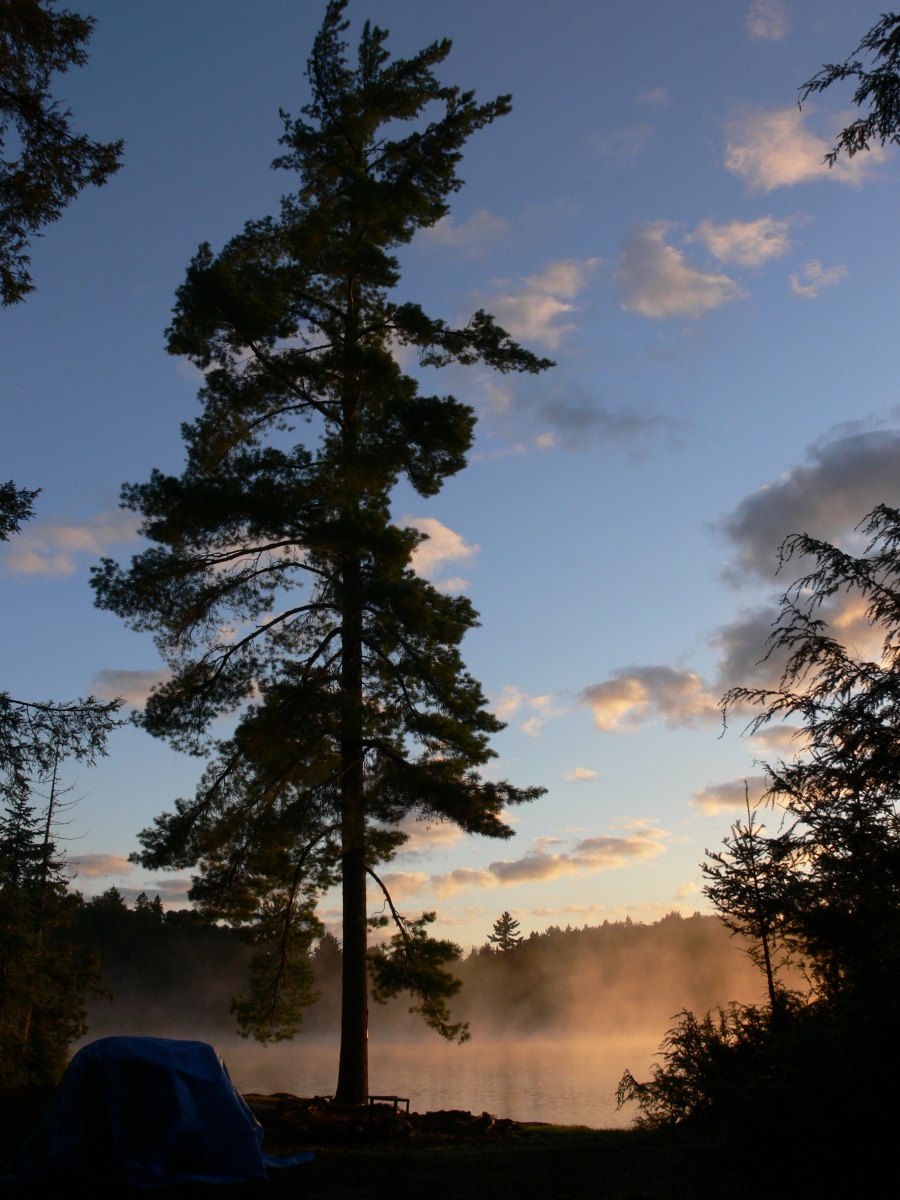
(900×1200)
We can’t go back, but we must not forget to visit the City on the Hill. Be in awe of small wonders wherever you find them — the universe is reflected in just a drop of water. And look to the horizon wherever you can — who knows what spires you will find there.
Photos by Henry J. de Jong
For more photos and videos visit
Newmaker Notes: Amiens Cathedral
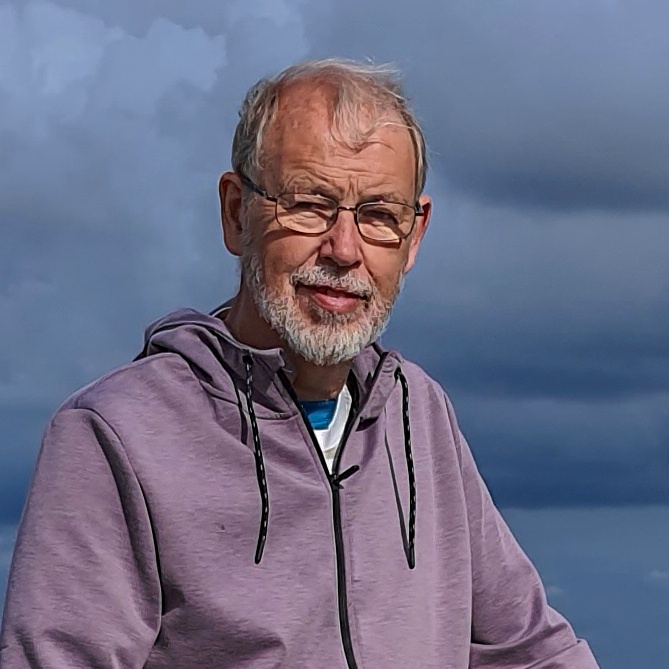
(669×669)
Article bio: Henry de Jong is a retired carpenter and craftsman who would have been happy in the service of cathedral building. Mountainview is as close as he got.
Author bio: Henry de Jong is a retired renovator and active new maker who lives in St. Catharines, Ontario. He is his families’ heritage curator and likes to gather things up in websites like Newmaker Notes.
City on a Hill
Version 1 (shorter)
Try as I might, I cannot relive Amiens Cathedral. In spite of having spent time there last summer, loitering long within its cavernous space and taking a great many photos, the experience has receded to the realm of recollection — a meagre substitute for the real thing. I am grateful for having had it, and for the lasting impression that it made on me, but I lament that I cannot go there before breakfast again to renew it, to see it in a new light or to share it with others.
Amiens was our only stop between Barcelona and the Netherlands. We went there purely for the the cathedral. It’s not that there isn’t much else to see in any cathedral city, but they do stand out, and this one more than others — it is the largest in France. The bar had been set with Chartres, the first true Gothic cathedral, finished the year that Amiens was started in 1220. I had visited Chartres half a century ago with my brother, and then studied both of them in my first year university Gothic Cathedrals course. Visiting one again was high on my list.
The intentions of the cathedral builders are both well documented and simply obvious — maximum height and maximum light. Putting aside the inevitable self-aggrandizements of some key contributors, the glory of these accomplishments was meant to reflect God. Simply sincere, God-fearing builders endeavoured to shine the light of Christ into the world — to present a “city on a hill” that cannot be hidden (Mathew 5:14).
They were enduringly, endearingly successful. Eight hundred years later the cathedrals are still standing and receive millions of visitors yearly, quite apart from the faithful. In many places there is still no competition — the churches can be seen from afar, piercing horizons with their single-minded aspirations.
But for Christians who are not so lucky as to live in view of a cathedral, there is no surrogate ‘City of God’ asserting centrality, pressing the earth with its permanence, reaching for the heavens, bathing us in light and inviting us to stand in awe. Some of our churches echo these vaulted ideals, and of course the mountains and the hills still break forth with God’s grandeur.
Generally though, the competition has been lost. Stadiums, malls, and towers of all kinds draw the masses away from God, and the mundane iteration of streets, hydro lines, houses and strip malls distract us from any awe at all. Our worship trends to the personal and spiritual now — only the mind need be elevated — and the over-arching parish presence has given way to the fractured freedom of worship.
We can’t go back, but we must not forget to visit the City on the Hill. Be in awe of small wonders wherever you find them — the universe is reflected in just a drop of water. And look to the horizon wherever you can — who knows what spires you will find there.